Pedals and Cycling Shoes: These Shoes Were Made for Biking
One of the beauties of riding a bike is that it needs very little equipment to ride. A half-decent bike, some comfortable clothing, and you're off. However, similar to most sports, once you go slightly above the entry level riding you start to want to improve your riding experience. As you gain more experience you will most likely start to think of ways in which you can increase your speed, comfort, and distance, especially if you ride with others that have been riding longer than you. One of the ways in which to accomplish this desire for improvement is by upgrading the components of your bicycle. And as good as place as any to start is with your pedals and shoes.
Pedals
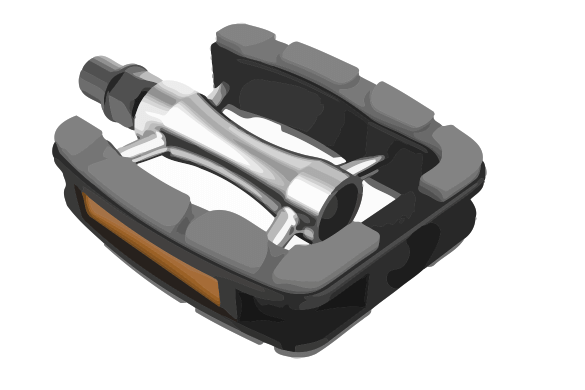
Entry-Level Pedals
Regular flat pedals, if you are just riding in the park with your kids, are just fine. However, they have some major disadvantages when it comes to performance. The push phase is extremely short. That is, force can only be exerted when the foot is at approximately the two o'clock mark, up to the five o'clock mark at best. Outside of that the foot can't exert any force on the pedal. In fact, the non-forcing foot will be resting on the pedal and acting as a dead-weight during the force phase of the other foot. In addition, your foot can easily slip off the pedal, especially if you're doing some off-road riding.
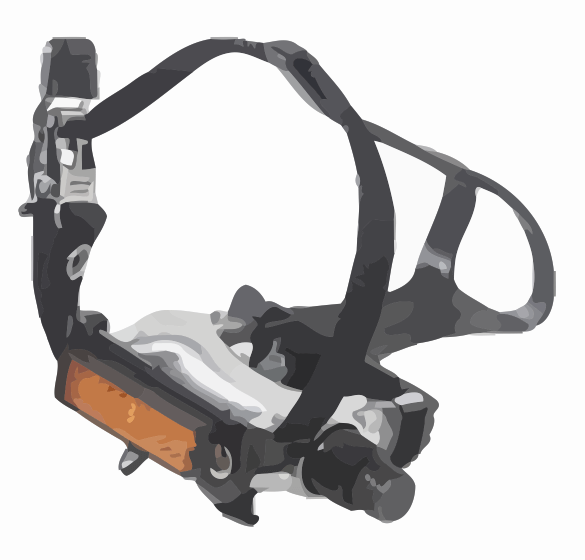
Mid-Level Pedals
The first step up from regular pedals are those with straps and a simple cage that encloses the front of the foot i.e. toe clips. With toe straps the front of the foot will be able to exert force through slightly more of the rotation. Instead of only applying force from the two to the five o'clock mark, you might be able to apply force from the one to the six o'clock mark. And if you tighten the straps sufficiently you can apply a bit of force in the upward phase also.
The major disadvantage of the strap, is that your foot is trapped. So if you have to stop you must first reach down with your hand and loosen the straps. If you don't have time to do this, such as during an emergency stop or at a sudden red traffic light, you will most certainly fall over.
Higher-End Pedals
At this level the pedals lock your shoe/foot in place with a special locking mechanism. This might sound a bit scary to a non-experienced rider, but it is in fact a safe system and is certainly safer than the strap/clip. Yes, the foot is locked in, but it will easily become unlocked with a quick twist of the foot. It is, in practice, much easier to disengage your foot from the pedal with this system than with the strap.
This toe strap system is called ‘clipless'. The name is odd, but it originates from many years ago, before special shoes and pedals came out when toe straps used to be called clips. When the special locking mechanism was introduced someone had to think of a term that would indicate there are no clips and so the term clipless was born.
The clipless system requires special shoes with cleats. These cleats, as already mentioned, is what locks into the pedal.
The main disadvantage of this system is the cost of the pedals and the shoes, which can range from a couple of hundred dollars to several hundred dollars. Another complication with clipless pedals is the position of the cleats on the shoes. If they are not placed, or lined up, properly on the sole of the shoe you will end up with sore knees and possibly chronic injuries.
The advantages are their weight, more so with expensive shoes, and the fact that the cyclist can exert force through the entire foot rotation. Although this requires some training to be able to do, once learned, it can greatly increase the pedalling efficiency.
There are numerous types of clipless pedals but they all work on the same principle. When shopping around you should consider the types of shoe cleats you want to use. If you have more than one bike you need to make sure the pedals match with your shoes, unless you want to have more than one pair of shoes with cleats. You should do your research first and then stick with one design. Otherwise, it will get expensive quite quickly. There is no significant performance advantage or disadvantage with one type of cleat or another. It's mostly a matter of personal choice.
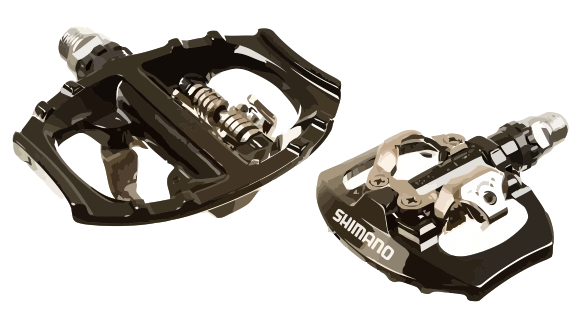
Additional considerations:
- Once you decide to go clipless make sure you practice clipping and unclipping, with both feet. Make sure you become comfortable with this system before heading on the road with other cyclists and with traffic.
- Some pedals allow for unclipping by twisting inward as well as outward.
- Some pedals allow for more swivel, or lateral movement, of the foot before the foot will unclip. This allows for more natural movement of the foot during pedalling, which might be important if you suffer from sore knees.
- Most pedals will have a small screw/spring which allows you to adjust how much force is needed to unclip the shoe.
- Pedals may be double sided, meaning the shoe will clip in on both sides.
- Some pedals may have the clipping mechanism on one side only, while being flat on other side. An excellent choice if you sometimes ride with regular shoes.
- Some clipless pedals can only be used on one side. The other side does not have clips and it is not flat, meaning, it's not suitable for anything.
- Cleats wear out with time and may require replacing. You can tell when this is needed as they will begin to slip out too easily and the spring can't be tightened any more.
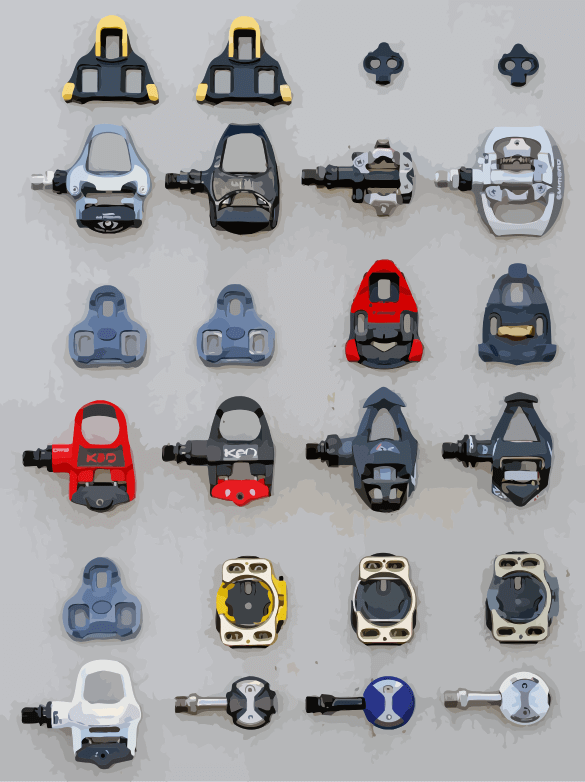 Clipless Pedals and Cleats
Clipless Pedals and CleatsChoices of Cycling Shoes
Regular
By regular I'm referring to shoes, or even sandals, that have nothing to do with cycling. Their main advantages are their simplicity and their cost, as you don't need to buy anything else.
Disadvantages:
- The sole is soft and bendable. This means that while you are pushing you will be losing force that could be going into the crankset because the sole will bend.
- Related to this, you will need to use more energy to try and keep your foot stiff. This will take away energy that could be going into pedalling.
- The force phase will be limiting, as we mentioned above, with flat pedals or straps.
Stiff Soled Shoes
These shoes are designed for cycling and will be stiff allowing for more force to be passed into the pedalling mechanism. It will also reduce fatigue of the foot and calf muscles. Most of these shoes come with the option to cut out a piece of the sole so you can install cleats, but until you do they are sealed underneath.
 Cycling Shoes (off-road) with Recessed Cleats
Cycling Shoes (off-road) with Recessed Cleats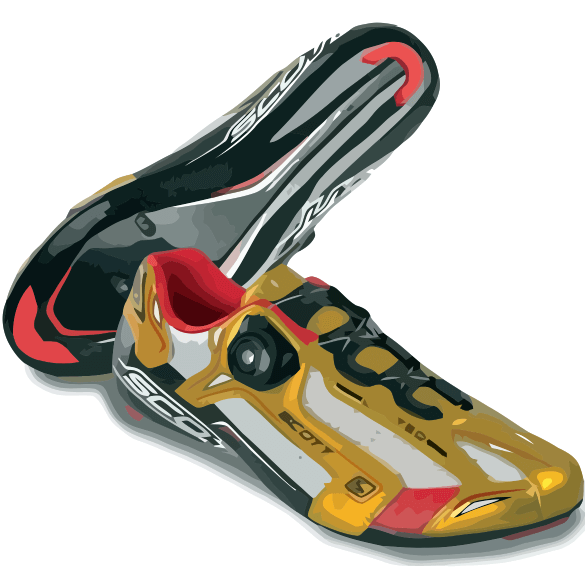 High-End Road Cycling/Triathlon Shoes
High-End Road Cycling/Triathlon ShoesCycling Shoes
These will have a stiff, hard sole and cleats. They will be more expensive but they will offer the best cycling experience and offer the most energy transfer and pedalling efficiency.
Other advantages, if you are willing to pay for higher quality, is their weight. The more expensive shoes will also come with fancy tightening and loosening mechanisms which might be important for triathletes that need to don and remove them quickly.
Some types of shoes may come with recessed cleats, which means you can walk fairly comfortably with them once you are off the bike. Shoes that are not recessed will be very awkward to walk in, and possibly even dangerous. Which ones you choose will be a personal choice, probably based on how much walking you do during your rides.
Final Notes
- Keep the cleats clean and dry. Most of them will rust if you don't take care of them.
- If you ride through muck, clean them afterwards. If mud dries it will make it hard for you to ‘clip' into on your next ride.
- Check them regularly to make sure they didn't come loose from the shoe with use.
- If doing a multi-day ride take an extra set of cleats with you, just in case.
- When trying on shoes do it later in the day. Our feet swell a bit during the day, and if we try new shoes on in the morning they might feel fine but by the evening they will feel tight. With stiff-soled shoes comfort is vital as they will start to hurt your feet after a couple of hours of riding. However, don't get them too loose as they will not provide proper pedalling efficiency.




Leave a Reply